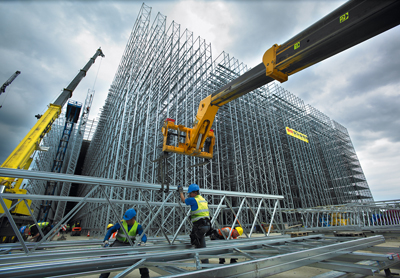 Click on image to view more information.
Click on image to view more information.
Construction employment rises, but unevenly, in January; metro job gains are spotty

Editor’s note: Construction Citizen is proud to partner with AGC America to bring you AGC Chief Economist Ken Simonson's Data DIGest. Check back each week to get Ken's expert analysis of what's happening in our industry.
The value of nonresidential construction starts, not seasonally adjusted, increased 13% from January 2015 to January 2016, CMD reported on February 11, based on data it collected. Building starts climbed 8.5%, with institutional starts up 2.6%, commercial up 13% and the small industrial segment up 10%. Heavy engineering starts jumped 20%, with the largest segment, road/highway, jumping 39%.
The Federal Highway Administration's National Highway Construction Cost Index, a measure of prices paid by state transportation departments for all roadway construction contracts, decreased 2.4% in September 2015 from June and 1.7% from September 2014. The index has fluctuated narrowly since March 2012. The index had much wider swings from 2003 to 2012 but the September 2015 reading is virtually the same as in March 2005.
Consultancy IHS and the Procurement Executives Group (PEG) reported on January 27 that "construction costs fell again in January, although declines were not as widespread....The headline current IHS PEG Engineering and Construction Cost Index...registered 43.3 this month, up from 41.8 in December. Despite this slight increase, the headline index has been consistently below the neutral mark for 13 months." A reading higher than 50 represents upward pricing strength; below 50, downward pricing strength. "The current materials/equipment price index [increased] to 39.6 from 37.8 in December,...the lowest level recorded since the survey began four years ago. All underlying material and equipment components showed falling prices except ready-mix concrete, which showed prices unchanged....Copper-based wire and cable as well as carbon steel pipe registered the softest reading among equipment and materials....The subcontractor labor index rose to 52.1 from 51.1."
"A [cement] price increase of $10-$15/ton is being implemented in several markets throughout the U.S. this spring (April)," investment analyst Thompson Research Group wrote on January 26. "Critical to cement pricing is the reality that the industry as a whole is close to being at full capacity utilization, and some markets are already there. Given stringent federal emission regulations, it is highly unlikely that a new cement plant will be built in the next 5-10 years....We believe there is a high likelihood that the majority of these price increases will be mostly accepted in most markets, with the one exception being that of Texas....Concrete pricing continues to improve in most markets. We would caution, however, that concrete pricing has been less consistent in certain regions vs. aggregates and cement. That said, to receive much more widespread positive feedback on pricing is a big positive given that concrete/ready-mix producers consistently have been less successful in gaining significant pricing over the past 5+ years. Note we are by no means suggesting that there are strong increases in concrete pricing in all markets as the downstream pricing environment remains spotty." The U.S. Geological Survey noted in its 2016 Mineral Commodity Summary for cement, posted on January 28, "Production continued to be well below the record level of 99 million tons in 2005, and reflected continued full-time idle status at a few plants, underutilized capacity at many others, and plant closures in recent years. Cement sales increased significantly in 2015, with much of the increase accounted for by imports; overall, sales were still nearly 35 million tons lower than the record volume in 2005.
In the fourth quarter of 2015, a seasonally adjusted 63.7% of households were homeowners, down from 63.9% a year earlier and the lowest fourth-quarter homeownership rate since 1989, according to data the U.S. Census Bureau posted on January 28. The fourth-quarter rate has declined for 11 consecutive years. In the same release, Census reported that the vacancy rate for rental housing, not seasonally adjusted, in the fourth quarter was 7.0%, the same as a year earlier and the lowest fourth-quarter vacancy rate since 1993. Together, these series suggest continuing strong demand and tight supply for rental housing, conditions supportive of further multifamily construction.
Many state colleges and universities are in a budget squeeze that may force them to cut construction, although recent news has been mixed. Census data posted on February 1 showed state and local higher education construction spending set a record (before adjusting for inflation) in June 2015 but declined 11% by December at a seasonally adjusted annual rate, AGC calculated. Full-year spending increased 10% in 2015 from 2014 and 15% from its low point in 2013. But the 2015 total was virtually unchanged from the previous high set in 2009. That cost has caused an increase in annual debt service from $25 million annually to $100 million." In a January 28 blog post, "Higher Ed Funding Cuts, State by State," the Center on Budget and Policy Priorities wrote, "funding for public two- and four-year colleges remains well below pre-recession levels in almost every state, as our fact sheets show....Our 2015 paper explained that, between the 2007-08 and 2014-15 school years (after adjusting for inflation): Forty-seven states cut spending per student—all except Alaska, North Dakota and Wyoming....There is some good news, however. Between fiscal years 2014 and 2015, 37 states raised per-student funding, by an average of nearly 4 percent, after adjusting for inflation." On Wednesday, University of California at Berkeley chancellor Nicholas Dirks released an "open letter" to his campus, reporting a $150 million shortfall that would require unspecific spending cuts. Part of the problem, the Chronicle of Higher Education reported on February 11, is that "the state has not issued any bonds for university construction since 2006, according to Berkeley. During that period, however, the institution has spent more than $2 billion on building projects, 60% of which were necessary to protect the campus from earthquakes, according to the university's data.


